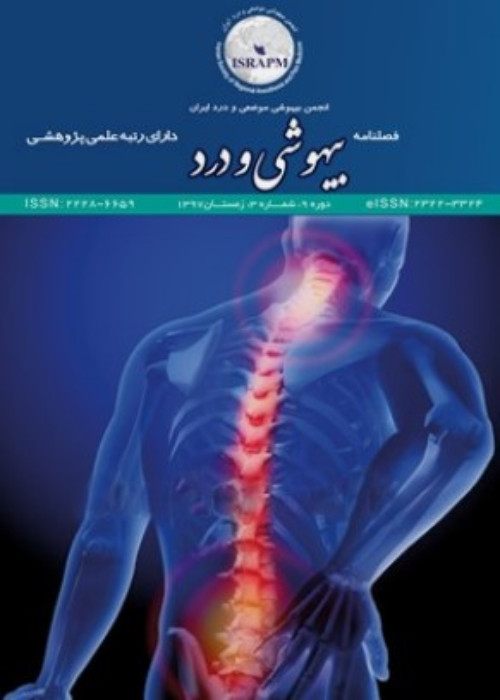The effect of adding epinephrine to 5% lidocaine in spinal anesthesia for cesarean section in patients admitted to Mostafa Khomeini hospital in Ilam
Author(s):
Abstract:
Aims and
Background
One of the most common surgeries in women is cesarean section. Hence, it is important to choose an anesthetic technique which is safe, appropriate and affordable for mom and baby. Spinal anesthesia is one of such techniques for which drugs with the least possible damage and most efficacy should be chosen. Among the additives to local anesthetics, "epinephrine" is an appropriate choice. Epinephrine is commonly used together with local anesthetic to induce tense block and it seems that adding epinephrine to lidocaine would improve sensory block during spinal anesthesia. Materials And Methods
This study is a randomized double blind clinical trial. 60 female patients were referred to the operating room of Mostafa Khomeini hospital in Ilam. The patients were divided into two groups receiving lidocaine alone and lidocaine plus epinephrine. The first group received 60mg lidocaine 5% and the second group received 60mg of lidocaine 5% and 0.2 mg epinephrine. Afterward, variables such as systolic blood pressure, diastolic blood pressure, heart rate, respiratory rate, and arterial oxygen saturation by pulse oximetry, level of sensory, motor and sympathetic block, and Apgar score of neonate at 1 and 5 minutes plus possible complications of anesthetic drugs were recorded. Finally the findings were analyzed by multivariate statistical methods. Findings
We measured different kinds of variables and the results are as follows. Average Pulse Rate after 5 minutes in the first and second groups were, 101/8 ± 31/51 and 107/4 ± 25/04, respectively. This was statistically significant among the groups. A higher level block was more common (with exception in one dermatome) in group one (lidocaine alone) which was confirmed to be statistically different (P <0/04). Regarding blood pressure decrease, no significant difference was shown between the two groups. Conclusion
According to this study, we can conclude that there has been a longer continuation of the sensory, motor and sympathetic block in the group receiving lidocaine plus epinephrine in comparison with the group who received lidocaine alone. In this study the use of additional anesthetic agents was also dramatically reduced. This in fact expresses the efficacy of epinephrine in prolonging local anesthetic effect.Keywords:
Language:
Persian
Published:
Journal of Anesthesiology and Pain, Volume:5 Issue: 2, 2014
Pages:
19 to 31
magiran.com/p1293371
دانلود و مطالعه متن این مقاله با یکی از روشهای زیر امکان پذیر است:
اشتراک شخصی
با عضویت و پرداخت آنلاین حق اشتراک یکساله به مبلغ 1,390,000ريال میتوانید 70 عنوان مطلب دانلود کنید!
اشتراک سازمانی
به کتابخانه دانشگاه یا محل کار خود پیشنهاد کنید تا اشتراک سازمانی این پایگاه را برای دسترسی نامحدود همه کاربران به متن مطالب تهیه نمایند!
توجه!
- حق عضویت دریافتی صرف حمایت از نشریات عضو و نگهداری، تکمیل و توسعه مگیران میشود.
- پرداخت حق اشتراک و دانلود مقالات اجازه بازنشر آن در سایر رسانههای چاپی و دیجیتال را به کاربر نمیدهد.
دسترسی سراسری کاربران دانشگاه پیام نور!
اعضای هیئت علمی و دانشجویان دانشگاه پیام نور در سراسر کشور، در صورت ثبت نام با ایمیل دانشگاهی، تا پایان فروردین ماه 1403 به مقالات سایت دسترسی خواهند داشت!
In order to view content subscription is required
Personal subscription
Subscribe magiran.com for 70 € euros via PayPal and download 70 articles during a year.
Organization subscription
Please contact us to subscribe your university or library for unlimited access!


